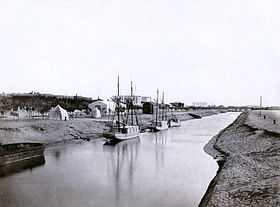Sweet Water Canal
This article is about the canal in Egypt.
For the general concept of a "fresh water canal", see Aqueduct (watercourse)
and
Canal.
| Sweet Water Canal |
|---|
 |
| Specifications |
|---|
| Status |
Open |
|---|
| History |
|---|
| Construction began |
1861 |
|---|
| Date completed |
1863 |
|---|
| Geography |
|---|
| Start point |
Lake Timsah |
|---|
| End point |
Port Said |
|---|
Sweet Water Canal, also known as Fresh Water Canal or Ismaïlia Canal, is a Canal in Egypt built to facilitate construction of the Suez Canal by providing fresh water from Lake Timsah to Suez and Port Said.[1](p267) Sweet Water Canal has facilitated the growth of agriculture of settlements along the Suez Canal, and it particularly important for supplying water to the city of Port Said. Like the Suez, it was designed by French engineers; construction lasted from 1861 til 1863.[2] It runs through the now-dry distributary of the Wadi Tumilat,[2] incorporating portions of an ancient Suez Canal that existed between Old Cairo and the Red Sea.[1](pp251–257)
During the 1950s when British soldiers were stationed in the area, the waterway was reputed to be foul-smelling and contaminated, and Royal Air Force personnel were advised to avoid contact with the water.[3]
References
- ↑ 1.0 1.1 Rappoport S. "Chapter V: "The Waterways of Egypt"". History of Egypt (Project Gutenberg). Volume 12, Part B (London: The Grolier Society) https://www.gutenberg.org/ebooks/17332. Retrieved 11 March 2013.
- ↑ 2.0 2.1 Encyclopaedia Britannica, 11th edition, s.v. "Suez Canal". Accessed 8 August 2008.
- ↑
Whilst serving with the Royal Air Force, between August 1953 and January 1956, I had postings to three RAF camps in the 'Canal Zone'. These were Kabrit, Kasfareet and Fayid. As a Motor Transport Driver, almost on a daily basis, I drove various vehicles along the "Treaty Road", which was, I understand, built by the British Army at some time. For the most part, both the "Treaty Road" and the "Canal Road" ran parallel to each other. The "Canal Road", having been built and maintained by the French, contained a superior surface to the 'British' counterpart! The "Sweet Water Canal" was the name used by Egyptian natives and ALL British servicemen at the time in question.
It was a common place occurrence to see dead cattle and dogs floating in this 'canal' at all times when passing this 'waterway' between the Kasfereet bridge/railway level-crossing and Fanara. The "Treaty Road" ran alongside this very smelly edifice, and servicemen were reminded by medical bulletins, that we were on no account to use the water, or even touch the contents!—C.A.Pearce
|
|---|
| | Authorities | | |
|---|
| | Cities and ports | |
|---|
| | Infrastructure | |
|---|
| | Marine life | |
|---|
| | History |
|
|---|
|
